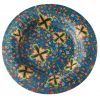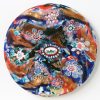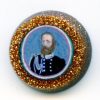In the first half of the nineteenth century the glass makers on Murano were going through the most difficult period in their history.
One of the strategies they adopted to overcome this crisis was to study and revive ancient techniques, adapting them to the fashion of the times. One of these was the production of murrino glass, already known in Roman times and adopted by Venetians in the fifteenth century, and it was thus revived and modernised.
It is created by combining different pieces of glass together when cold. Once the desired pattern has been obtained, it is heated in the kiln, so that the glass components soften and bond together and it looks like a multi-coloured mosaic. When this technique was revived, the nineteenth-century glass makers also used “millefiori” (‘thousand flower’) rods that were made of concentric layers of different coloured glass with a star-shaped interior thanks to the use of particular moulds. Once the layers had been heated, the rod was stretched; when it had cooled down it was then cut into cylindrical segments creating the murrine, which were then incorporated into pieces worked in the ancient style or blown.
Whilst Vincenzo Moretti (1835-1901) produced the most important examples of glass made using this technique, it was Giovanni Battista Franchini (1804-1873) who invented thinner and more complex millefiori rods, abandoning the traditional star and creating new designs; with these his son Giacomo specialised, resulting in amazing miniaturised portraits that were mainly dedicated to the most famous people of that period (Pope Pius IX, Emperor Franz Joseph, etc.). This virtuoso and exhausting work truly put Giacomo to the test, so much so that he went mad: thus in 1869 his father was given an award in Murano, as if he were being compensated “for the amazing invention of the rod portraits that caused him the almost irreparable loss of a son...”



